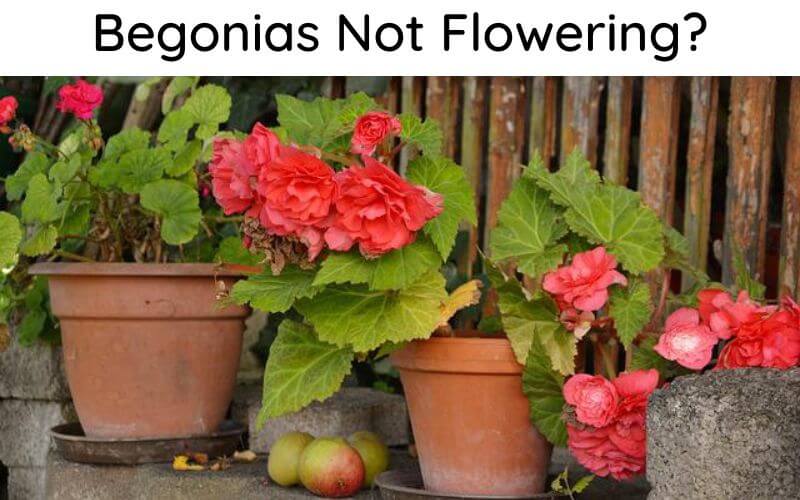Begonias fail to flower when they don’t get adequate sunlight or get too much sunlight. Begonias also fail to flower when they’re overwatered. Begonias also fail to flower when they don’t get the required nutrients. Begonias need a balanced fertilizer that releases slowly into the soil.
Begonias are usually grown indoors for their beautiful flowers. These plants can also be grown in shaded summer beds.
Begonia is a genus of 2000 species. The plants are grown as ornamental houseplants in areas with a cooler climate.
Wax and tuberous Begonias bloom from early summer till frost. There are some types that bloom year-round.
In this article, we shall discuss why Begonia fails to flower. You’ll learn about the cultural practices that help the plant blossom.
What month do Begonias flower?
Begonias that were planted in February should start flowering in June. Plants that were planted later blossom in July.
They start blooming in early summer. Plant your Begonia in peat moss or Vermiculite for the best blossoms.
How long do Begonia flowers last?
Begonia blooms for up to 6 months. There are some varieties that bloom for longer than this. The blossom period also depends on where you grow them, i.e., indoors or garden.
Begonia flowers last for months unless some disease/disorder attacks the plant.
Sunlight
Begonias need the right amount of sunlight to blossom properly. Too much or too little sunlight hinders flowering.
Begonias need shade during the hotter hours of the day. Ensure that your plant gets some shade in the afternoon.
Place your pot of Begonia on the North or East side of the house. You may want to place this plant under the patio or under a large tree.
Begonia gets stressed if gets direct sunlight. Read the label when buying and plant the Begonia accordingly.
Overwatering
Begonia plant fails to flower when the plant is given more water than needed. Never let your Begonia sit in waterlogged soil.
Begonias need a lot of water but don’t let the soil get soggy. Water only when the soil is dry up to an inch.
Insert your finger into the ground to check this. Water during the early hours of the day. The excess water dries off during the day.
Water your potted Begonia every day. Do it every other day if you live in an area with high humidity.
Begonia flower beds require about 2.5 inches of water weekly. This depends on the soil conditions and the weather too.
Why are my Begonias all leaf and no flowers?
Begonia will produce lots of healthy leaves without blossoms when the plant gets more Nitrogen than needed.
Nitrogen promotes the growth of leaves at the expense of flowers. The plant goes into a vegetative mode if it gets too much Nitrogen.
Apply a fertilizer that has equal proportions of all the required elements. You can also apply a fertilizer that promotes blossoms.
Don’t apply a lot of fertilizer at once. This could yield the opposite results. Begonias need a small, steady boost of fertilizer to keep blooming.
How often should Begonias be fertilized?
Fertilize your Begonias fortnightly. The two-week gap works the best because Begonias are heavy feeders.
Apply fertilizer early in the season for the best results. Gentle applications are ideal for Begonias.
What kind of fertilizer do Begonias need?
Give your plant a 20-20-20 slow-release fertilizer. This fertilizer has the perfect blend of the elements your Begonia needs to flower plentifully.
Slow-release fertilizer eliminates the chances of fertilizer burn.
Is Miracle Grow a good fertilizer for Begonias?
Yes, Miracle grow is a great fertilizer for Begonias. This fertilizer can be applied to both young and mature plants.
Add Miracle grow fertilizer to a part of the loam to prevent any issues.
Should I fertilize tuberous Begonias?
Yes, you need to fertilize tuberous Begonias for the best blossoms. Feed your tuberous Begonias slowly as they’re heavy feeders.
Dilute a 20-20-20 fertilizer and feed your tuberous Begonias throughout the growing season gradually.
Leggy growth
Begonia becomes leggy when the plant doesn’t get adequate sunlight. The plant stretches its stems and leaves out to get some sunlight.
The plant becomes leggier unless you move it to a sunnier spot. Transition the plant to a brighter place gradually.
Begonias don’t blossom when they get an inadequate amount of sunlight. Prune your Begonia from top-down after fixing the plant’s light needs.
Remove the leggy parts and pinch back the stray leaves to keep your Begonia bush in shape.
What to do with Begonias after flowering?
Begonias rest for a few weeks after they’re done flowering. You need to help your Begonia through the winter.
This process is called overwintering. Your plant doesn’t need much nutrition during this resting phase. This happens after the first frost.
Cut back the stems and leaves off your Begonia. Do not disturb the rootball or the soil stuck to it. Dust the tuber with sulfur powder to prevent fungal diseases.
Put each tuber in a paper bag. Place the shaved plant in a cold, dark room. Let the tubers cure for several weeks. Prune off the remaining roots/stems at this point.
How to keep Begonias blooming?
Follow the below instructions to make/keep your Begonias blooming.
- Provide adequate water to your Begonias. Water when the top two inches of the soil goes dry. Also, don’t let your Begonia sit in waterlogged conditions. Check the soil with bare fingers if needed.
- Place your Begonia in a proper location. Ensure the plant gets some shade in the afternoon. Place the plant on the North or East side of the house for the best results.
- Does the soil drain well? Increase the soil drainage by adding Perlite/sand to it.
- Make sure the plant gets adequate nutrition to support the blooms. Adding a slow-release fertilizer helps.
Happy Gardening 🙂

